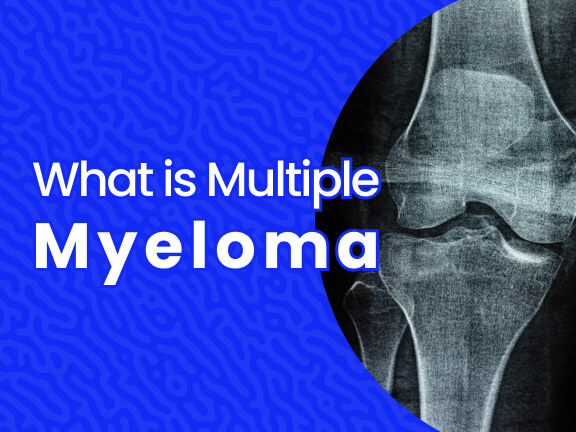What Is Multiple Myeloma?
Multiple myeloma is a cancer that develops in the plasma cells of white blood cells. Antibodies that recognize and attack germs are produced by healthy plasma cells, which aid in the battle against infections.
Cancerous plasma cells accumulate in the bone marrow and drive out healthy blood cells in multiple myeloma. Instead of producing beneficial antibodies, cancer cells create abnormal proteins that can cause problems.
Treatment for multiple myeloma isn’t always necessary right away. If multiple myeloma is slow growing and isn’t causing signs and symptoms, your doctor may recommend close monitoring instead of immediate treatment. For people with multiple myeloma who require treatment, a number of options are available to help control the disease.
What are Symptoms and Signs of Multiple Myeloma?

Signs and symptoms of multiple myeloma can vary, and, early in the disease, there may be none.
When signs and symptoms do occur, they can include:
- Bone pain, especially in your spine or chest
- Nausea
- Constipation
- Loss of appetite
- Mental fogginess or confusion
- Fatigue
- Frequent infections
- Weight loss
- Weakness or numbness in your legs
- Excessive thirst
How Does a Person Get Multiple Myeloma?
Myeloma is thought to start with a single abnormal plasma cell in your bone marrow, which is the soft, blood-producing tissue that fills the middle of most of your bones. The defective cell multiplies quickly.
Because cancer cells do not mature and subsequently die like regular cells, they collect and eventually outnumber healthy cell creation. Myeloma cells squeeze out healthy blood cells in the bone marrow, causing exhaustion and an inability to fight infections.
Myeloma cells, like healthy plasma cells, continue to try to make antibodies, but they produce faulty antibodies that the body can’t use. Instead, mismatched antibodies (monoclonal proteins, or M proteins) accumulate in the body, causing issues such as kidney damage. Cancer cells can also cause bone deterioration, increasing the chance of breaking a bone.
Almost all cases of multiple myeloma begin as a relatively benign illness known as monoclonal gammopathy of unknown significance (MGUS).
MGUS, like multiple myeloma, is marked by the presence of M proteins — produced by abnormal plasma cells — in your blood. However, in MGUS, the levels of M proteins are lower and no damage to the body occurs.
What Is the Life Expectancy with Multiple Myeloma?
Myeloma survival rates are generally determined by whether a single plasmacytoma is discovered or multiple myeloma is detected. A single plasmacytoma has a 78 percent, 5-year survival rate, while multiple myeloma has a 55 percent, 5-year survival rate. However, additional factors like the tumor’s cytogenetics (chromosome alterations), blood levels of specific proteins and other substances, kidney function, and your age and overall health can all influence your prognosis.
People newly diagnosed with myeloma may have a better prognosis than these statistics suggest. These figures are based on people who were diagnosed and treated at least five years ago.
What Are the Stages of Multiple Myeloma?
This staging system is based on the albumin level (more or less than 3.5 mg/dL) and B2-microglobulin level (< 3.5; 3.5-5 or > 5 mg/L).
The higher the stage, the poorer the outcome. This staging system is based on outcomes of more than 10,000 cancer cases.
Stage I: All of the following apply:
- β2-M less than 3.5 mg/L
- Serum albumin of 3.5 g/dL or more
- Normal LDH
- No high-risk chromosome changes in myeloma cells found by FISH test
Stage II: Not stage I or stage III.
Stage III: β2-M is more than 5.5 mg/L, plus one of the following:
- Myeloma cells have high-risk chromosome changes
- High LDH
What Is the Difference Between Myeloma and Multiple Myeloma?
There is no difference. Both terms are used synonymously. Myeloma comes from the Greek words “myel” (marrow) and “oma” (blood) (meaning tumor). Multiple myeloma is a term used to describe a condition in which malignant plasma cells appear in more than one site.
Multiple Myeloma Clinical Trials
Clinical trials are critically important to the development of new multiple myeloma treatments, and to help doctors better understand the disease itself. For many people with multiple myeloma, participation in a clinical trial may be a good option for treatment.
Massive Bio specializes in connecting multiple myeloma patients to free clinical trials, offering hope and peace of mind no matter their ability to pay, location, or any external factors.
Sources:












